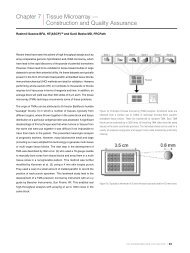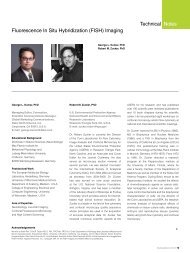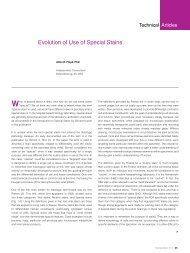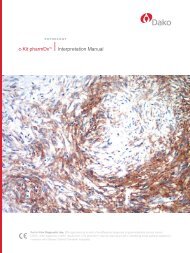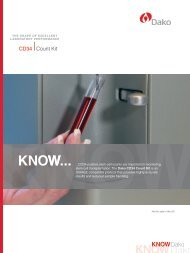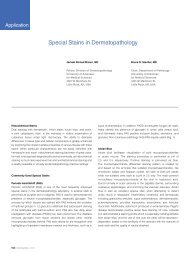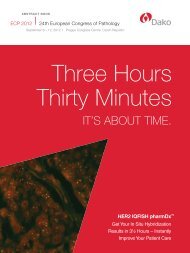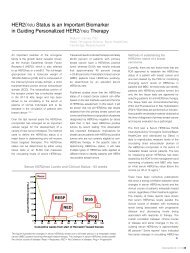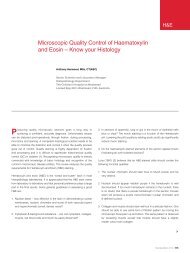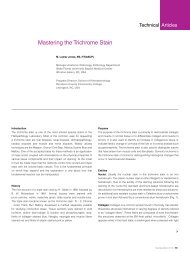Lipoproteins - Dako
Lipoproteins - Dako
Lipoproteins - Dako
- No tags were found...
You also want an ePaper? Increase the reach of your titles
YUMPU automatically turns print PDFs into web optimized ePapers that Google loves.
<strong>Lipoproteins</strong>Apolipoprotein A-IApolipoprotein B<strong>Dako</strong>’s lipoprotein testsystems for turbidimetryand nephelometryBased on high-qualitymonospecific antibodiesthat show high-securityantigen excess
ApolipoproteinsApolipoproteins are proteins that posess the ability to bind to lipids such ascholesterol and triglycerides in the blood. Apolipoproteins function in theregulation of lipoprotein metabolism through their involvement in the transportand redistribution of lipids among various cells and tissues. <strong>Dako</strong>’s polyclonalApolipoprotein A-I/B are optimized to quantitatively determine the concentrationof human apolipoprotein A-I/B using turbidimetry or nephelometry.Apolipoprotein A-IApolipoprotein A-I (apoA-I) is the major protein component of HDL cholesterol,which is associated with antiatherogenicity, a process that involves the reversetransport of cholesterol from tissues and arteries into the liver where it is removed.Apolipoprotein BApolipoprotein B (apoB) is the major protein component of LDL cholesterol,associated with pro-atherogenicity, a process where cholesterol is transportedto the arteries. This process results in the building up of plaques inthe arteries leading to atherosclerosis.Advantages of measuring lipoproteins to assess cardiovascular risksThe ratio of apoB/apoA-I is becoming a trusted method in assessing therisks of a patient developing cardiovascular complications, ischemic andcoronary heart diseases:1. The determination of the ratio of apoB/apoA-I is considered as thedirect estimation of the ratio of atherogenic/anti-atherogenic particles.The obtained ratio is therefore considered a strong cardiovascular riskpredictor as it benefits from leaving out the measurement of lipids carriedby these particles. It is also an advantage that the ratios of apoB/apoA-Ican be obtained at all lipid concentrations.(1)2. The conclusion from the INTERHEART study, which was conducted in52 countries with 27,092 individuals, concludes that the determinationof non-fasting apoB/apoA-I ratio was a superior, simple and inexpensivemethod to estimate risks of myocardial infarction (MI) and cardiovascularrisks in comparision to determining total cholesterol/HDL cholesterol ratios.(2)3. The availability of internationally accepted WHO/IFCC approved reference materialsfor apoA-I (SP1-01) and apoB (SP3-07) establishes the emerging acceptanceof apoA/apoB ratios as a more simple and accurate method to estimatethe cholesterol balance rather than lipid ratios or lipid/lipoprotein ratios.(3)References1. Walldius G, Jungner I, Holme I, Aastveit AH, Kolar W, Steiner E. High apolipoprotein B, lowapolipoprotein A-I, and improvement in the prediction of fatal myocardial infarction (AMORISstudy): a prospective study. Lancet 2001:10.1016/S0140-6736(01)07098-2.2. McQueen MJ, Hawken S, Wang X, et al. Lipids, lipoproteins, and apo-lipoproteins as riskmarkers of myocardial infarction in 52 countries (INTERHEART study): a case-control study.Lancet 2008;372:224–33.3. Marcovina SM, Albers JJ, Kennedy H, Mei JV, Henderson LO, Hannon WH.InternationalFederation of Clinical Chemistry standardization project for measurements of apolipoproteinsA-I and B. IV. Comparability of apolipoprotein B values by use of international referencematerials. Clin Chem 1994;40:586-92.PrecisionThe <strong>Dako</strong> assays show a low degree of imprecision,and the CV is consistently equal to or less than4.0%, see below.Apolipoprotein A-I Standard Deviation g/LSera Low Medium HighMean value (g/L) 0.69 1.94 2.18Within run 0.02 0.02 0.03Between run 0.02 0.02 0.03Total 0.03 0.03 0.04CV % 4.0 2.3 2.0Numbers ofmeasurement 36 32 36Apolipoprotein B Standard Deviation g/LSera Low Medium HighMean value (g/L) 0.45 1.94 1.33Within run 0.007 0.010 0.014Between run 0.012 0.008 0.014Total 0.014 0.013 0.020CV % 3.1 1.4 1.5Numbers ofmeasurement 30 30 30Samples and working proceduresSerum or plasma samples are recommmended.<strong>Dako</strong>’s lipoprotein assays comprise detailed workingprocedures for automated instruments and the abovereagents, which are available separately.Assays Measuring SecurityRangeRangeApolipoprotein A-1 Approx. 0.2 – 4.0 g/L Up to 30 g/LApolipoprotein B Approx. 0.1 – 2.6 g/L Up to 32 g/LPlease visit www.dako.com for a range of CE approvedapplication notes for a variety of platforms.ordering informationProduct Size CodeRabbit Anti-HumanApolipoprotein A-I 5 ml Q0496Rabbit Anti-HumanApolipoprotein B 5 ml Q0497Human Serum Lipoprotein– Calibrator 1 ml X0958Human Serum Lipoprotein– Low Control 1 ml X0961Human Serum Lipoprotein– High Control 1 ml X0962Dilution Buffer 1 1L S2005Reaction Buffer 1,for Cobas-Mira plus & others 1L S2007Reaction Buffer 3, for Hitachi 1L S2006EU regulatory status: CE-IVD (complies with Directive98/79/EC of the European Parliament and of theCouncil on in vitro diagnostic medical devices).Corporate HeadquartersDenmark+45 44 85 95 00Find your local distributor on:www.dako.comor contactReagent Partnership Division atrpsupport@dako.comDistributors in more than 50 countries38625 NOV 2013



